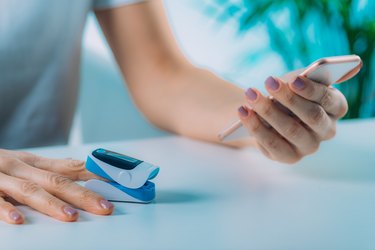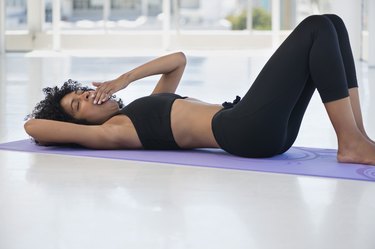

In a way, every exercise is aerobic. After all, when you work out, your heart and lungs are moving oxygen to your working muscles. They do this via your bloodstream, and you can tell how much oxygen is in your blood during exercise by using a pulse oximeter.
Your pulse oximeter measurement — a measure of blood oxygen saturation — naturally lowers as you begin exercise, but should return back to normal as your breathing rate increases. Your measurements of oxygen saturation during exercise vary depending on your health and exercise intensity.
Video of the Day
Video of the Day
What Are Normal Blood Oxygen Levels During Exercise?
In healthy adults, normal pulse oximeter readings range from 95 to 100 percent, according to the Mayo Clinic. Low levels are those under 90 percent (hypoxemia).
How a Pulse Oximeter Works
A pulse oximeter is a non-invasive piece of equipment, often used in a healthcare setting, typically placed on the end of your finger to measure your blood's oxygen saturation, according to the Mayo Clinic.
The device determines blood oxygen saturation by measuring the hemoglobin in your blood. Hemoglobin is the component of your red blood cells that binds to oxygen and carries it throughout your body. Hemoglobin's color depends whether it's bound to oxygen; it absorbs different waves of light depending on your blood's oxygen level.
So a pulse oximeter uses red and infrared lights to reveal how much hemoglobin you have — and how much of it is carrying oxygen through your blood stream.
For being non-invasive and so easy to use, pulse oximeters give a fairly accurate level of your oxygen saturation.
Benefits of Measuring Pulse Oximeter During Exercise
An exercise pulse oximeter measures the level of oxygen in your blood during exercise and is a useful tool for serious athletes and people with health problems. For example, athletes routinely engaging in vigorous exercise, particularly at high altitudes, may wear pulse oximeters to ensure adequate oxygenation.
People with respiratory illnesses or recovering from surgery, meanwhile, may find wearing an exercise pulse oximeter during exercise useful for monitoring oxygen levels.
3 Tools to Track Your Blood Oxygen During Exercise
- WearO2 Wearable Pulse Oximeter (Getwellue.com, $179.99)
- Garmin vívosmart 4 (Garmin.com, $129.99)
- Santamedical Fingertip Pulse Oximeter (Amazon.com, $18.95)
How Do Blood Oxygen Levels Change During Exercise?
Measuring oxygen saturation during exercise has many benefits, but it can also be misleading.
Why? When you first start a workout, your oxygen levels will likely fall. That's because, by changing various properties in your blood, physical activity lowers the amount of oxygen that is able to bind to hemoglobin.
However, your body quickly gets your oxygen levels back up. Your body adapts to different levels of oxygenation during physical activity by increasing your breathing rate. As your breathing rate increases, your blood oxygen levels can increase.
If your body is not getting enough oxygen during exercise, your breathing will become labored and you will likely not be able to continue.
Does Blood Oxygen Level Drop During Exercise?
Yes. Blood oxygen saturation initially drops during exercise as the body works to meet the demands of working muscles, according to a 2013 study Australian Journal of Basic and Applied Sciences.
Low Levels? Here's When to See a Doctor
If there are questions about a person's oxygen saturation during exercise, another form of measurement may be necessary. An arterial blood gas test, for example, provides accurate information about oxygenation levels during movement.
In some cases, hypoxemia is caused by heart issues or defects, or lung conditions such as bronchitis, asthma or emphysema, according to the Cleveland Clinic. Low blood oxygen can also be a side effect of some medications or sleep apnea.
See a doctor if you experience frequent symptoms of hypoxemia with exercise or at rest.


